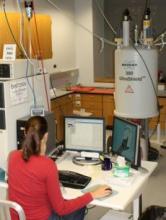The Bruker AVANCE300 NMR spectrometer is a wide bore (89mm), high resolution, solid NMR spectrometer operating at a magnetic field strength of 7 T (1H frequency is 300MHz). It has the following features:
For more details of individual nuclei, please see:
